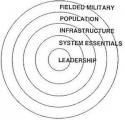If this is the case, then what's the point? IF all the terminology hits terminal velocity above a certain level, maybe that's what wrong at the "Big Map, Small Hand" level. Bigger question is, should we be willing to accept this as truth?
We've talked about this before on this board. As a tactics instructor it makes absolutely no sense to me that doctrinal terminology is not relevant above a certain stage. I have a feeling many of you disagree with me on this.






 I leave those applications to others, preferably after the turkey is finished.)
I leave those applications to others, preferably after the turkey is finished.)
 (I had to look isomorphic up - proved that a Phuddy Duddy can still use a dictionary
(I had to look isomorphic up - proved that a Phuddy Duddy can still use a dictionary )
) 
 .
.


Bookmarks